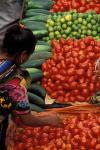Measuring food consumption

Most countries collect data on household consumption or expenditures by implementing surveys such as household budget, income expenditure, and living standards surveys. These surveys may be implemented to provide input for national accounts or the consumer price index, to measure poverty, or for other reasons. But the data are often used for purposes other than the ones for which the data were originally intended. For example, food consumption data may be used to assess food security or vulnerability and diet diversity, assessing business opportunities, or as an input for the design or monitoring of food fortification programs. Various communities of data users have different and specific needs; the criteria of relevance and reliability of food consumption data depends on the use that is made of the data. Making surveys relevant and reliable for various communities of users who "re-purpose" the data can potentially add considerable value to the data. The project Measuring Food Consumption describes the uses and users of food consumption data and their specific needs to assess the relevance and reliability of a large collection of surveys (based on a review of the survey questionnaires), and to formulate recommendations for the improvement of these surveys.
| Project status: | Close |
| Sponsor(s): | DFID Trust Fund No TF011722 administered by the World Bank, Development Data Group (WB-DECDG), and World Bank Development Grant Facility, Grant No 4001009-06, administered by the PARIS21 Secretariat at OECD |
| Implemented by: | Olivier Dupriez (World Bank Development Data Group), Lisa Smith (IHSN consultant), Nathalie Troubat (Food and Agriculture Organization) |
| Type of output: | (i) An assessment framework to evaluate food consumption data; (ii) a report on the global assessment of surveys and the resulting technical guidelines; and (iii) a meta database on survey methods. A complete draft of these outputs will be available in early 2013. |
Approach:
An assessment form was developed to compile information on the design of food consumption or expenditure survey modules. This form, provided here with related guidelines, was used to assess survey questionnaires from 100 countries. The metadata compiled using the form were exported to Excel and Stata and provide the meta database used for an analysis of the reliability and relevance of data, based on criteria defined by the following user communities:
- Poverty analysts
- National accountants and consumer price indices (CPI) compilers
- Food security experts, and compilers of Food Balance Sheets
- Nutritionists, in particular food fortification specialists
- Other uses and users (private sector, research community)
A description of the needs of national accountants was obtained by implementing the related project: "Household surveys and national accounts"
A similar project is being implemented, to assess the measurement of "household non-food consumption or expenditures.
Intermediary output:
The following form, “Food consumption or expenditure surveys,” was used for the assessment. During the analysis phase of the project, weaknesses were identified in the form; a revised version and guidelines on its use and implementation will be provided in 2013. In addition, the following Stata and MS-Excel files, “Assessing food consumption surveys,” provide a metadatabase of information compiled from surveys from 100 countries. The database corresponds to the assessment form and provides the necessary data dictionary.
